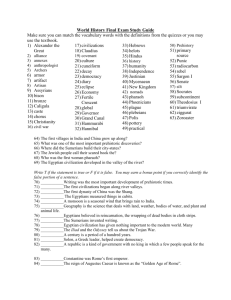Ch 1 PPT
advertisement
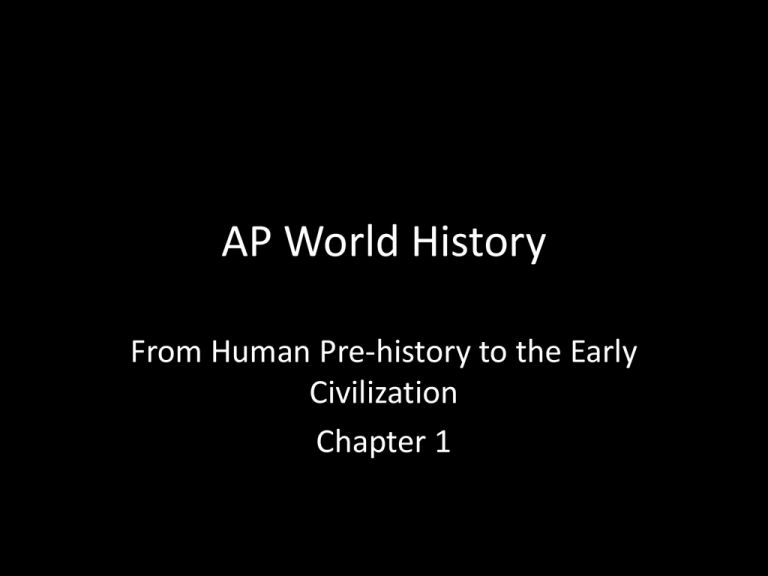
AP World History From Human Pre-history to the Early Civilization Chapter 1 What is prehistory? • The things that happened to humans before their was written records. • It is a lot like a vast black space penetrated by only an occasional pinpoint of light, representing our current knowledge. Definitions of civilization Elements: • Urban, monumental building, writing, specialized, occupations • Human Life in the Era of Hunters and Gatherers. • Homo sapiens by 10,000 B.C.E. – larger brain – tools, weapons Developments by 12,000 B.C.E.: • Hunting-gathering • Art • Spread to Europe, Asia, Australia, the Americas. The development of human creatures. • A human like creature, or hominid, was walking about in East Africa more than 5.5 million years ago, by latest reckoning. What is the difference between a human and an ape? • Deviations in bone structures of the foot and hand, the size of the brain, and the use of language. The Paleolithic Age • The appearance of the first tool making hominids about 10,000 B.C.E. • Also known as the Old Stone Age. • (paleo = old; lithos = stone) • Seventeen varieties of hominid evolved. • All of them became extinct between 50,000 and 10,000 years ago. Human Life before Agriculture Paleolithic Culture : • Old Stone Age to 14,000 Y.A. • Homo sapiens sapiens c. 240,000, Y.A. Late Paleolithic Developments: • Variety • Bands of hunter-gatherers • Agricultural settlements Gender division of labor: • Men: hunting, fishing, defense • Women: gathering, making medicine • Spread from Africa c. 750,000 Y.A. Neanderthal Man • Flourished in Western Germany about 30,000 years ago and then disappeared about the same time that Homo Sapiens appeared in Europe. What is civilization? • “Civilization is a movement and not a condition, a voyage and not a harbor.” (Arnold J. Toynbee) • A complex, developed culture usually associated with specific achievements. How did civilization begin? • People began to grow food instead of chasing or gathering food. • This began to happen about (8000-5000 B.C.E) • *The Agricultural Revolution. What does stationary agriculture do for a society? • • • • • • CREATES Urban living. Law. Government officials. Writing. Military forces. Socioeconomic classes. What are the four river societies where civilizations began? • • • • Mesopotamia. (Fertile Crescent) Nile River Valley. Indus River valley. Yellow River valley. Results of the Agricultural Revolution. • A steadily expanding population that lived in permanent settlements. • It created the concept of “mine versus thine.” Privately owned property. • Specialization of jobs and labor. The Neolithic Revolution – 8000 to 3500 B.C.E. The Spread of the Neolithic Revolution: • Hunting-and-gathering persists • Pastoralism Sub-Saharan Africa: • root and tree crops Northern China: • Millet • Rice • Southeast Asia, to China, India, islands Mesoamerica, Peru: • Maize, manioc, sweet potatoes • Bronze Age Spread of Agriculture: Çatal Hüyük • c. 7000 B.C.E., southern Turkey. • Large fortress like complex. • Agriculture and commerce • Shrines. • Specialization of labor. Metal and Its Uses: • First metal used by humans seems to have been copper. • Bronze came next for weapons, art, and tools. (Called the Bronze Age 7000 to 1500 B.C.E) • Iron is the key metal of history. The Hittites learned to smelt iron in 1200 B.C.E. Iron is more common, stronger, durable, and sharper then bronze. Aspects of civilizations? Cities: • writing • political organization Writing: • cuneiform Nomads: (Picture) • Herding society • Sustenance existence • War like Mesopotamian Civilizations Tigris-Euphrates Civilization: • Mesopotamia Sumerians: • from 3500 B.C.E. • Alphabet, Cuneiform writing • City-states, – Ziggurats, Human Sacrafice. • Religion, Polytheistic. • Priesthood, gods were cruel and unpredictable. – No Trace of Ethics. Akkadians: • Babylonians • Hammurabi code • Spread Sumerian Culture • Sumerian Government – City States Why are the Sumerians important? • • • • • Built the first large cities up to 100,000 people. First sophisticated system of writing. Invented the wheel as a load bearing device. First to use sun baked clay bricks. First to use the plow, and gravity flow irrigation system. Sumerians and Math: Set time • • • • 60 minutes. 60 seconds. The 360 degree circle stems from the Sumerians. Much of what we know of Geometry and Trigonometry was expanded by the Sumerians. Epic of Gilgamesh • • • • First Epic Poem. Story of Garden of Eden. Story of the Flood. Gilgamesh searches for the secret of immortal life. • The Gods jealous of his power defeat him. Hammurabi • Babylonian King who took steps to control the Mesopotamian region. • Compiled the first known code of law. • The laws had been around for years. • The laws attempted to bring equality to the weak and cause justice to prevail in the land. Criminal Law • Vengeance was no longer a personal thing but a thing controlled by the state. • Established punishments for offenses against others such as robbery, assault, and murder. Civil Law • This branch of law deals with private rights and matters, such as business contracts, taxes, marriage, and divorce. African Civilizations Egyptian Civilization: (MAP) • Pharaoh • Pyramids • from 2700 B.C.E. • Kush (Picture) Cracking the Hieroglyphic Code • Napoleon’s military found the Rosetta Stone when they invaded Egypt in 1799 during the Napoleonic Wars. • He ordered ink impressions from the stone sent to European scholars. • The Stone contained three languages. • Made it possible to translate Egyptian Hieroglyphics. The Hittites • Developed the ability to work iron. • Iron was more common then copper or bronze. • Iron was sharper and harder then bronze. • The Hittites were able to arm more men because of the cheap Iron. • They soon invaded Mesopotamia. • The empire collapsed and iron use spread. The Assyrians The Terror Kings • By 1100 B.C.E Learned to forge iron weapons and invaded their neighbors. • They gained the reputation as the most ruthless people in all of Mesopotamia. • “The city and its houses, from top to bottom, I destroyed and burned with fire.” – Babylon destroyed by the Assyrians A Nomadic People • Abraham migrated from Mesopotamia to the land of Canaan. • The land of Canaan was controlled by the Egyptians. • The Hebrews fled to Egypt during a great famine. • Moses led the Hebrews out of Egypt and back to Canaan. The Kingdom of Israel • By 1000 B.C.E the Israelites had set up a kingdom with Saul as the first king. • King David further expanded the Kingdom and was successful in conquering Jerusalem, which then became the Hebrew capital. • Solomon David’s son built the famous Temple of Jerusalem. Solomon was the most famous Jewish King but also was not liked for his high taxes. One True God • The beliefs of the Israelites differed in that they were Monotheistic. • With this belief came a belief that they were gods chosen people. Sea People Invasions • Phoenicians • Alphabet from 1300 B.C.E. http://www.salimb eti.com/micenei/s ea.htm Indian River Valley Civilizations Indus River: • Harappa, Mohenjo Daro • Indo-Europeans Earliest Indian Civilization • Mohenjo-Daro was first Indian civilization. • We know little of this first culture. • We do know that their cities had massive populations even as large as those of Sumer. • This civilization lasted 1000 years then just faded away. City Planning • The cities of Mohenjo-Daro and Harappa were both planned cities. • Very large Three miles in circumference. • Wide roads, city walls. • Strong government. • Strong leaders. Religious Beliefs • Ancient India was Polytheistic. • Ancient worship of the Bull. • Modern worship of cattle. Decline and Disappearance • By 1750 B.C.E the quality of life in the Indus Valley Cities was declining. • Crude pottery replaced the finer works of earlier days. • Mud slides, Volcanoes, and earthquakes possibly contributed to the destruction. Chinese River Valley Civilizations • Shang Shang Government • Built large palaces, rich tombs, and had armies led by women. • Government was set up around a clan system. • The government was loosely structured between many families or clans. Shang Bronze Work • Unique in their Bronze work. • Almost a perfect bronze Shang Social Classes • Shang soldiers used bronze weapons, leather armor, and horse drawn chariots. • They had artisans and merchants. • Most people were peasants. – – – – Lived in thatch pit homes. Farmed with stone tools. Forced to repair dikes. Forced to fight alongside local lords in war. Shang Religious Beliefs • Prayed to many gods. • (Polytheistic) • Chief God was Shang Di. – Mother goddess who brought plants and animals to earth. • Gods did not speak to mere mortals, but to kings and nobles. • Lower classes of people had to appeal to their ancestors, through sacrifice and prayer. • Slaves = No soul so they could be safely killed. Shang Religion Yin and Yang • Chinese religion believed in a delicate balance between two great forces. • Yin = linked to earth, darkness, and female forces. • Yang = linked to heaven, light, and male forces. Shang System of Writing • Pictographs = Pictures represent things. • Ideographs = Signs that expressed thought. • Oracle Bones = Shang priests wrote on animal bones and turtle shells. – The priest would heat the bones or shells till they cracked then they would interpret the cracks. • Calligraphy = Art for those who learned to write. The First Civilizations, Conclusion Isolation of Civilizations: • Division among peoples • Contacts increase with time Big Questions • What advantages does an agriculturally based society have over a hunter gatherer based society? • Compared to non-civilized societies, what are the major drawbacks of civilization? • Why is the development of writing important in the history of the river valley civilizations? • Compare the main features of Egyptian and Mesopotamian civilizations. What did the two civilizations have in common as early civilizations? What were their main differences in values and organization? • Why was Jewish monotheism a significant development in the religious history of early civilization?

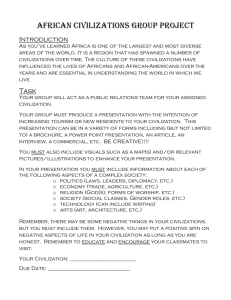

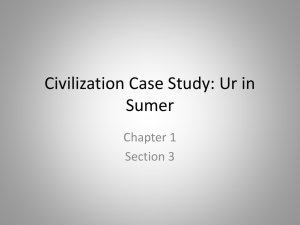
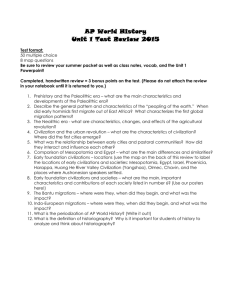

![world history - New Page 1 [je074.k12.sd.us]](http://s2.studylib.net/store/data/009977422_1-26b439736c031db692fcb89a191e6c98-300x300.png)
